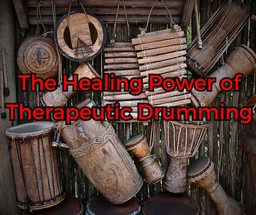Posted by Steve Head on 18th Jun 2024
The Healing Power of Therapeutic Drumming
As someone deeply passionate about the art of percussion, I’ve discovered that drumming isn’t just about creating rhythms—it's a powerful tool for mental, emotional, and physical healing. The concept of therapeutic drumming has gained significant recognition in recent years, and for good reason. This in-depth blog post explores the multifaceted benefits of therapeutic drumming, backed by research and personal insights.
What is Therapeutic Drumming?
Therapeutic drumming involves using rhythm and percussion instruments, primarily hand drums, as a medium for promoting health and well-being. It’s a practice rooted in ancient traditions, where drumming was used in rituals and healing ceremonies across various cultures. Today, therapeutic drumming is employed in clinical settings, wellness programs, and community groups to address a wide range of health issues.
The Science Behind Therapeutic Drumming
1. Stress Reduction and Anxiety Relief
Drumming has a profound impact on reducing stress and anxiety. Research has shown that engaging in rhythmic drumming can activate the body’s relaxation response, lower blood pressure, and reduce stress hormones. A study conducted in 2016 found that group drumming significantly decreased anxiety and depression among participants. The repetitive nature of drumming induces a meditative state, allowing the mind to unwind and release tension.
2. Boosting Mood and Emotional Well-being
The act of drumming stimulates the release of endorphins, the body’s natural “feel-good” chemicals. This endorphin rush can lead to improved mood and a sense of euphoria similar to that experienced during physical exercise. Drumming in a group setting also fosters a sense of community and belonging, which can be incredibly uplifting for individuals facing emotional challenges.
3. Physical Health Benefits
Drumming is a full-body workout that enhances physical health in multiple ways. It improves motor coordination, enhances dexterity, and strengthens the muscles of the arms, shoulders, and back. Additionally, the physical activity involved in drumming can help manage chronic pain by distracting from discomfort and triggering the release of pain-relieving endorphins.
4. Cognitive Enhancements
Engaging in rhythmic activities like drumming has been shown to improve cognitive functions, including memory, attention, and executive function. A 2020 study highlighted that drumming could enhance cognitive abilities and upper limb coordination in people with neurological conditions such as dementia. The bilateral coordination required in drumming activates both hemispheres of the brain, promoting mental agility and cognitive resilience.
Applications of Therapeutic Drumming
1. Mental Health Therapy
Therapeutic drumming is increasingly used in mental health settings to support individuals dealing with depression, anxiety, PTSD, and other mental health conditions. The rhythmic patterns and communal aspects of drumming provide a safe space for emotional expression and processing trauma. Programs like Health Rhythms, developed by neurologist Barry Bittman, have demonstrated significant benefits in reducing stress and improving mood.
2. Rehabilitation and Physical Therapy
Drumming can be an effective tool in rehabilitation programs for individuals recovering from physical injuries or surgeries. It aids in improving motor skills, increasing range of motion, and enhancing overall physical coordination. Drumming exercises tailored to individual needs can accelerate the recovery process and make rehabilitation more engaging and enjoyable.
3. Community and Social Connection
Participating in drum circles and group drumming sessions fosters social interaction and community building. This sense of belonging and shared purpose can be particularly beneficial for individuals feeling isolated or disconnected. Community drumming events create an inclusive environment where people from diverse backgrounds can come together, share rhythms, and build meaningful connections.
Personal Experiences and Testimonials
Having witnessed firsthand the transformative power of therapeutic drumming, I can attest to its profound impact. Participants often share stories of how drumming helped them cope with stress, find a sense of purpose, and reconnect with their emotions. One participant described their experience as "a journey into the self," where the drum became a tool for self-expression and healing.
Getting Started with Therapeutic Drumming
1. Choose Your Drum
Hand drums such as the djembe, cajon, and frame drums are popular choices for therapeutic drumming. Each drum offers a unique sound and feel, so it’s important to choose one that resonates with you. For beginners, starting with a simple hand drum like a djembe or cajon can be an excellent way to explore different rhythms and techniques.
2. Find a Drum Circle or Therapist
Look for local drum circles or workshops where you can join group drumming sessions. If you prefer a more personalized approach, consider finding a therapist trained in therapeutic drumming. Many communities offer drum circles that are open to all skill levels, providing a welcoming environment to learn and grow.
3. Practice Regularly
Consistency is key to reaping the benefits of therapeutic drumming. Dedicate time each week to practice drumming, whether in a group setting or on your own. Use drumming as a form of meditation to center yourself and relieve stress. Incorporate different rhythms and techniques to keep your practice engaging and challenging.
The Role of Music in Healing
Music has always played a crucial role in human culture and healing. Drumming, in particular, is a universal language that transcends cultural barriers. It has been used in ceremonies, rituals, and healing practices across the world. The rhythmic nature of drumming aligns with the body's natural rhythms, promoting a sense of harmony and balance.
Research and Future Directions
Ongoing research continues to explore the vast potential of therapeutic
drumming. Studies are examining its effects on various populations,
including veterans with PTSD, individuals with neurological disorders,
and children with developmental challenges. The growing body of evidence
supports the integration of drumming into mainstream therapeutic
practices.
Conclusion
Therapeutic drumming is a powerful and accessible way to enhance your
mental, emotional, and physical well-being. Whether you’re seeking
stress relief, emotional healing, or physical rehabilitation, drumming
offers a holistic approach to health that taps into the innate rhythms
of life. I encourage you to explore this incredible practice and
experience the transformative power of therapeutic drumming.
Check out The Healing Power of the Drum: A Psychotherapist Explores the Healing Power of Rhythm by Robert Lawrence Friedman on Amazon.com
By delving into therapeutic drumming, we can unlock new pathways to
healing and personal growth, making every beat a step towards better
health.
As an Amazon Associate, I earn from qualifying purchases. This means that if you click on the link and make a purchase, I may receive a small commission at no extra cost to you. This helps support my work in providing quality content. Thank you for your support!


